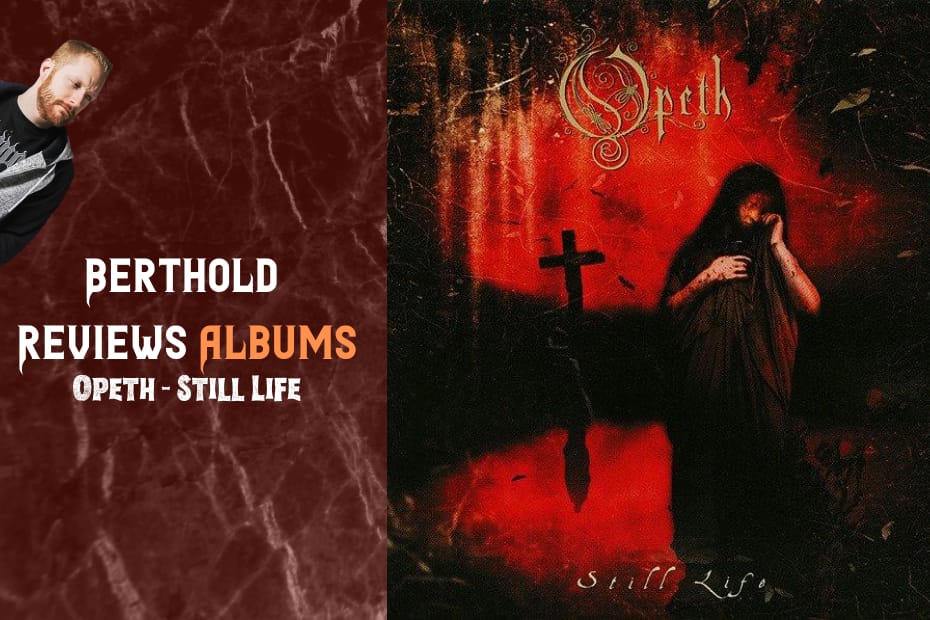90’s Score: 8/10
2020 Score: 10/10
While the ’90s was rather turbulent for the titans of thrash metal, it proved to be the birth of a new era for heavy metal. New scenes were emerging and bands were further diversifying their sound across the globe. In the United States, groups like Pantera, Fear Factory, Machine Head, and Type O Negative were ushering in a new era of heavy metal. Across the pond, however, the advent of melodic death metal was fueled in Europe by bands like Carcass, At the Gates, and Edge of Sanity, the latter of which introduced progressive elements into their music. Fusing progressive rock & creative elements into death metal became widespread in the mid-’90s as one of the progenitors of progressive death metal emerged: Opeth.
Regarded as a seminal album in the genre, Still Life makes up 1/3rd of Opeth’s holy trinity from 1998 to 2001, with the other two treasures being My Arms, Your Hearse and Blackwater Park. Their 1999 release encapsulated the band’s ability to fuse the inherent charm of progressive rock with the fiercely dexterous aspects of death metal. The cryptic and haunting introduction of the album’s opening track, “The Moor,” fuses into an acoustic interlude to lull you into a trance. The melancholic introduction quickly transitions into unmerciful death metal, ripe with sinfully delightful riffs and sinister beats. Hyperbole aside, “The Moor” perfectly exhibits Opeth at its peak: a band that defied labels and averted being a death metal typecase by pushing the boundaries of music with unconventional songwriting.
One aspect about Still Life that grew on me over the years is Mikael Akerfeldt’s vocals throughout the album. His ability to seamlessly transition from gracefully angelic vocals to macabre, demonic growls remains unmatched to this day. Unfortunately, the devout Opeth fanatics that decry the lack of death metal vocals on new albums tend to outweigh those that appreciate Akerfeldt’s evolution over the years. However, I can’t help but reminisce about the good old’ days when listening to Still Life because his growls contain immense power and emotion that have yet to be replicated.
The eclectic nature of Still Life provides a wealth of diversity spread out over seven tracks. “Godhead’s Lament” contains malevolent riffs courtesy of Peter Lindgren and Akerfeldt, providing an equally excellent follow up to the album’s opening track. Bassist Martin Lopez & drummer Marin Mendez, the band’s skillful rhythm section, provide crushing beats that match the unadulterated fury of the band’s guitarists. “Serenity Painted Death” is anything but serene, delivering a pulverizing assault for the first two minutes before delving into the song’s main lyrical content, which I find myself singing EVERY DAMN TIME:
“White faced, haggard grin / This serenity painted death / With a halo of bitter disease / Black paragon in lingering breath.”
“Benighted” and “Face of Melinda” serve as soothing reprieves amid the hellacious death metal, illustrating the ingenious songwriting from the band’s imaginative architect. “Benighted” is easily the most docile track on the album, bereft of death metal vocals or any punishing strikes. “Moonlapse Vertigo” vacillates between diabolical and angelic melodies more than any other song on the album. While it seemingly falls under the radar upon first listen, it ends up packing a punch equally as potent as any other song on the album.
“White Cluster” brings Still Life to an end with probably the most diverse track on the record. The songwriting is unequivocally magnificent on the finale as it brings the album’s concept to a close. Rooted underneath the music is a particularly compelling tale dealing with a banished heretic (aka the main protagonist) returning to the town that expelled him long ago. After falling in love with Melinda, who, in turn, becomes deemed a heretic and murdered by the town’s religious zealots, the protagonist exacts his vengeance before being sentenced to death. “White Cluster” deals with the main character’s final moments in isolation, reflecting on the fleeting moments of life before being dismissed from his mortal shell. The visceral journey throughout the album comes to a finale with passionate vocals, tumultuous mood swings, sorrowful interludes, and sublime musicianship.
Reflecting back on my younger self, I get a greater sense of why I under-appreciated not only this album but all of Opeth’s music. It wasn’t until I exposed myself to all forms of music and journeyed outside my comfort zone that I developed a greater appreciation for poignant songwriting. In my youth, I devoured everything “fast and heavy” to gratify satiate the energetic headbanger within. However, Still Life is about as perfect as an album can get, transitioning from one of the best albums of the ’90s into an instant classic.
